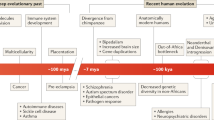Abstract
Although natural selection might be expected to reduce the incidence and severity of disease, disease persists. Natural selection leads to increases in the mean fitness of populations and so will reduce the frequency of disease-associated alleles, but other evolutionary processes, such as mutation and gene flow, may introduce or increase the frequency of these deleterious alleles. The pleiotropic actions of genes and the epistatic interactions between them complicate the relationship between genotype and phenotype, and may result in the preservation of disease-associated alleles. Deleterious alleles may also be maintained because of linkage to beneficial alleles. The inability of natural selection to eliminate diseases of aging is a reminder that fitness – success in producing progeny, or in contributing genes to the population gene pool – is not equivalent to the absence of disease. Nutritional or psychosocial cues may lead to life history strategies that maximize survival to reproductive maturity at the expense of disease later in life. Natural selection acts on genes, cells, and groups, as well as on organisms; the outcome of evolution reflects selection at different levels of biological organization. Finally, the human environment is constantly changing, largely because of the evolution of our parasites and because of changes in cultural beliefs and practices; genetic evolution is comparatively slow and lags behind environmental change. An evolutionary nosology complements traditional medical nosologies and enhances our understanding of the persistence of disease and the meaning of human variation.
Similar content being viewed by others
References
D.J.P. Barker (Eds) (1992) Fetal and Infant Origins of Adult disease British Medical Journal London
L.W. Buss (1987) The Evolution of Individuality Princeton University Press Princeton
B. Charlesworth (1994) Evolution in Age-Structured Populations EditionNumber2 Cambridge University Press Cambridge
D.A. Coall J.S. Chisholm (2003) ArticleTitle‘Evolutionary Perspectives on Pregnancy: Maternal Age at Menarche and Infant Birth Weight Social Science & Medicine 57 1771–1781 Occurrence Handle10.1016/S0277-9536(03)00022-4
A. Cunningham (1992) ‘Transforming Plague: The Laboratory and the Identity of Infectious Disease’ A. Cunningham P. Williams (Eds) The Laboratory Revolution in Medicine Cambridge University Press Cambridge 209–244
Darwin, C.: (1859). On the Origin of Species. London: John Murray. Rpt. Cambridge: Harvard University Press, 1964.
P.V. Davis J.G. Bradley (1996) ArticleTitle‘The meaning of normal’ Perspectives in Biology and Medicine 40 68–77 Occurrence Handle8946761 Occurrence Handle1:STN:280:ByiC3c3isFY%3D
S. Distante et al. (2004) ArticleTitle‘The Origin and Spread of the HFE-C282Y Haemochromatosis Mutation’ Human Genetics 115 269–279 Occurrence Handle10.1007/s00439-004-1152-4 Occurrence Handle15290237 Occurrence Handle1:CAS:528:DC%2BD2cXnt1GktLw%3D
W.F. Doolitte C. Sapienza (1980) ArticleTitle‘Selfish Genes, the Phenotype Paradigm and Genome Evolution’ Nature 284 601–603
W.H. Durham (1991) Coevolution: Genes, Culture, and Human Diversity Stanford University Press Stanford
P.W. Ewald (1994) Evolution of Infectious Disease Oxford University Press New York
K.H. Faber (1930) Nosography: The Evolution of Clinical Medicine in Modern Times EditionNumber2 Hoeber New York
M. Greaves (2002) ArticleTitle‘Cancer Causation: The Darwinian Downside of Past Success?’ Lancet Oncology 3 244–251 Occurrence Handle12067687 Occurrence Handle1:CAS:528:DC%2BD38XjsFWjs7c%3D
D. Haig (1993) ArticleTitle‘Genetic Conflicts in Human Pregnancy’ Quarterly Reviews Biology 68 495–532 Occurrence Handle1:STN:280:ByuC2MbosVY%3D
C.N. Hales D.J.P. Barker (2001) ArticleTitle‘The Thrifty Phenotype Hypothesis’ British Medicine Bulletin 60 5–20 Occurrence Handle1:STN:280:DC%2BD38%2Fot12mug%3D%3D
G. Hesslow (1993) ArticleTitle‘Do We Need a Concept of Disease?’ Theoretical Medicine 14 1–14 Occurrence Handle10.1007/BF00993984 Occurrence Handle8506536 Occurrence Handle1:STN:280:ByyB1c7psFI%3D
K. Hill H. Kaplan (1999) ArticleTitle‘Life History Traits in Humans: Theory and Empirical Studies’ Annual Review of Anthropology 28 397–430 Occurrence Handle10.1146/annurev.anthro.28.1.397 Occurrence Handle12295622 Occurrence Handle1:STN:280:DC%2BD38ros1CmtQ%3D%3D
D.L. Hull (1980) ArticleTitle‘Individuality and Evolution’ Annual Review of Ecology and Systematics 11 311–332 Occurrence Handle10.1146/annurev.es.11.110180.001523
T. Kirkwood (1999) Time of Our Lives: The Science of Human Ageing Oxford University Press New York
J. Kovács (1999) ArticleTitle‘The Concept of Health and Disease’ Medicine, Health Care and Philosophy 1 31–39
M.G. Marmot (2003) ArticleTitle‘Understanding Social Inequalities in Health’ Perspective in Biology and Medicine 46 S9–S23
E. Mayr (1964) ‘Introduction’ C. Darwin (Eds) On the Origin of Species Harvard University Press Cambridge
R.M. Nesse (2001) ArticleTitle‘On the Difficulty of Defining Disease: A Darwinian Perspective’ Medicine, Health Care and Philosophy 4 37–46 Occurrence Handle10.1023/A:1009938513897 Occurrence Handle1:STN:280:DC%2BD3MvkvVWltA%3D%3D
R.M. Nesse G.C. Williams (1994) Why We Get Sick: The New Science of Darwinian Medicine Time Books New York
Online Mendelian Inheritance in Man (OMIM): 2004, http://www.ncbi.nlm.nih.gov/Omim/. Accessed Feb. 2.
L.E. Orgel F.H.C. Crick (1980) ArticleTitle‘Selfish DNA: The Ultimate Parasit’ Nature 284 604–607 Occurrence Handle10.1038/284604a0 Occurrence Handle7366731 Occurrence Handle1:CAS:528:DyaL3cXktl2muro%3D
J. Rees (2002) ArticleTitle‘Complex Disease and The New Clinical Sciences’ Science 296 698–701 Occurrence Handle10.1126/science.296.5568.698 Occurrence Handle11976444 Occurrence Handle1:CAS:528:DC%2BD38XjtlOhtbk%3D
D.J. Weatherall (2001) ArticleTitle‘Phenotype-Genotype Relationships in Monogenic Disease: Lessons from the Thalassaemias’ Nature Reviews Genetics 2 245–255 Occurrence Handle10.1038/35066048 Occurrence Handle11283697 Occurrence Handle1:CAS:528:DC%2BD3MXisVCqurs%3D
R.G. Wilkinson (1997) Unhealthy Societies: The Afflictions of Inequality Routledge New York
G.C. Williams (1957) ArticleTitle‘Pleiotropy, Natural Selection, and the Evolution of Senescence’ Evolution 11 398–411
C. Wills (1996) Yellow Fever, Black Goddess: The Coevolution of Peoples and Plagues Addison-Wesley Reading, MA
Author information
Authors and Affiliations
Corresponding author
Rights and permissions
About this article
Cite this article
Perlman, R.L. Why Disease Persists: An Evolutionary Nosology. Med Health Care Philos 8, 343–350 (2005). https://doi.org/10.1007/s11019-005-2655-z
Issue Date:
DOI: https://doi.org/10.1007/s11019-005-2655-z



